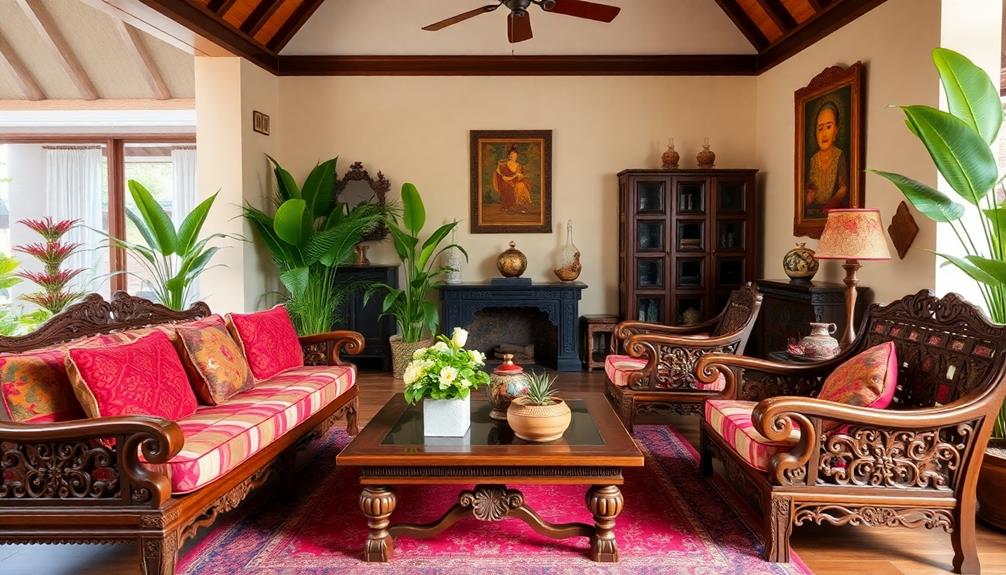Classical and modern architecture each tell a unique story about human creativity. When you look at classical buildings, you'll notice their emphasis on symmetry, proportion, and grandeur, often using sturdy materials like stone and marble. In contrast, modern architecture embraces minimalism with open spaces, using materials like glass and steel to create flexible structures. While classical designs evoke nostalgia and order, modern styles inspire innovation and interaction. These architectural forms reflect changing societal values and technological advancements over time. Curious about how these styles influence your surroundings? There's much more to explore in this fascinating architectural journey!
Key Takeaways
- Classical architecture emphasizes symmetry, proportion, and grandeur, reflecting stability and authority through intricate details and durable materials.
- Modern architecture breaks tradition with asymmetry, minimalism, and open spaces, prioritizing functionality and adaptability for diverse uses and lifestyles.
- Material choices differ significantly, with classical designs utilizing stone and marble, while modern styles incorporate steel, glass, and concrete for flexibility and transparency.
- Aesthetic values diverge, as classical architecture evokes nostalgia through muted tones and intricate designs, whereas modern architecture inspires innovation with bold colors and fluid layouts.
- The emotional connections also vary, with classical architecture promoting feelings of awe and nostalgia, contrasted by modern architecture's encouragement of creativity and interaction.
Historical Context

Classical architecture, with its grand columns and intricate details, finds its roots in the ancient civilizations of Greece and Rome. You can trace its development back to a time when societies valued stability and order, reflecting their cultural priorities.
As you explore this period, you'll notice how each structure served a purpose, often religious or civic, symbolizing authority and grandeur.
Fast forward to the 20th century, and you'll see a shift towards modern architecture, spurred by industrialization and technological advancements. Unlike classical styles, modern designs focus on innovation and functionality, mirroring the changing societal values.
This evolution in architecture not only showcases aesthetic preferences but also highlights the transformation of cultural ideals over centuries.
Design Principles
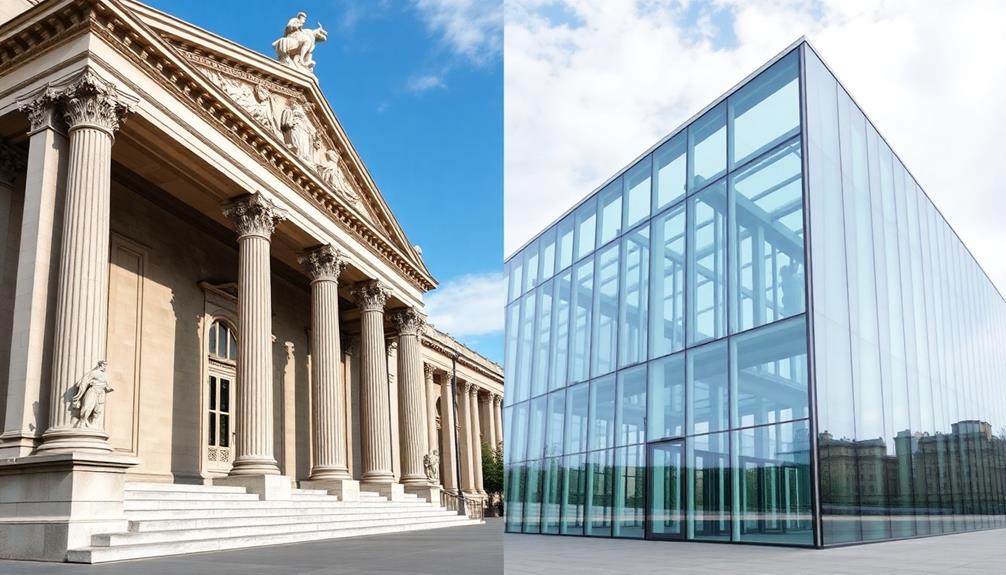
Embracing distinct philosophies, the design principles of classical and modern architecture reveal contrasting approaches to form and space. While classical architecture often emphasizes symmetry, ornate detailing, and grandeur, modern architecture leans toward minimalism, functionality, and the use of innovative materials. The transition from the embellished facades of the past to sleek, unadorned structures highlights the evolving priorities in design and culture. Interestingly, even within turreted architecture design insights, one can trace the blend of historical influences with contemporary reinterpretations, bridging the gap between tradition and modernity.
In classical architecture, you'll notice a strong emphasis on symmetry and proportion, creating a sense of order and harmony. Columns and pediments serve as prominent features, adding to the grandeur of the structures.
On the other hand, modern architecture breaks away from tradition, embracing asymmetry and minimalism. You'll find open spaces and fluid layouts that prioritize functionality over ornamentation.
This simplicity allows for a more dynamic interaction with the environment, creating versatile spaces. While classical designs evoke stability, modern aesthetics focus on innovation, offering a fresh perspective on how you experience and interact with the built environment.
Materials and Construction
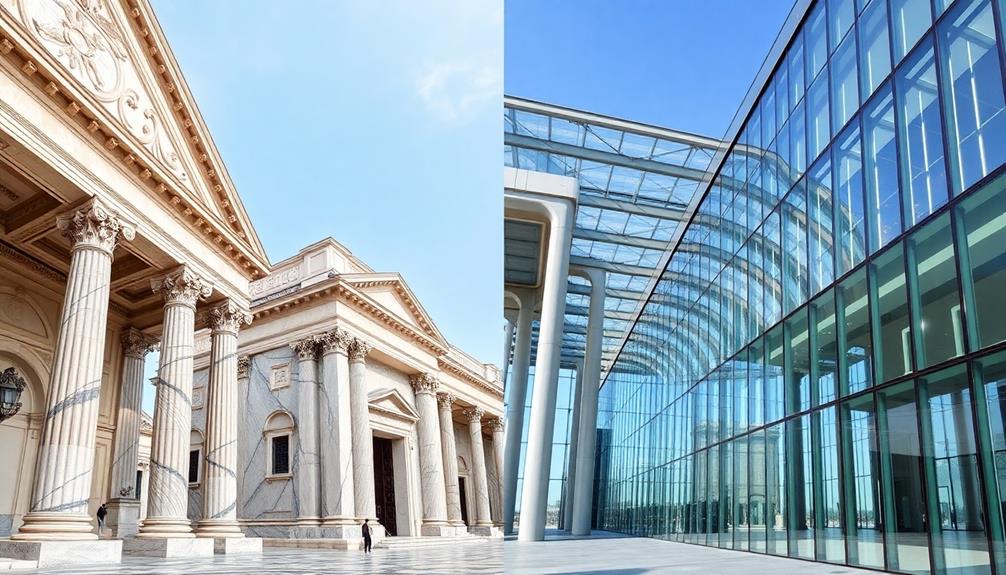
The choice of materials and construction methods significantly distinguishes classical architecture from its modern counterpart.
In classical designs, you'll find that durability and permanence come from the use of stone and marble, reflecting the era's values.
In contrast, modern architecture embraces innovation with materials like steel, glass, and concrete, allowing for lighter and more flexible structures.
This shift not only changes aesthetics but also opens up new possibilities for design.
Here are some key differences to reflect on:
- Classical: Stone and marble create grandeur.
- Modern: Steel enables open, airy spaces.
- Classical: Thick walls guarantee stability.
- Modern: Glass facades promote transparency.
Understanding these materials helps you appreciate how architecture evolves with technology and cultural shifts.
Functionality and Purpose
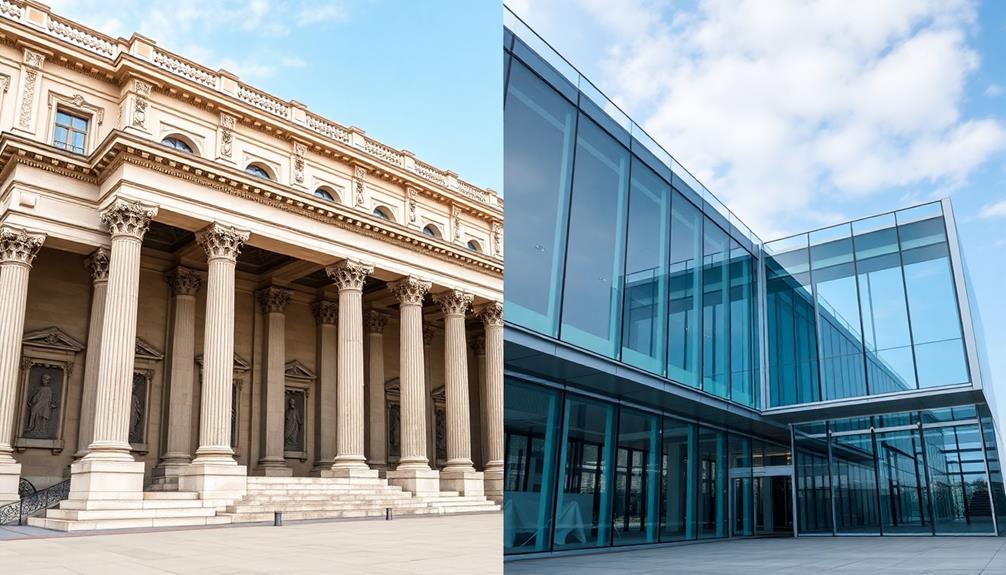
When it comes to functionality and purpose, architecture has transformed dramatically over the centuries.
Classical buildings often served specific religious or civic purposes, imposing a sense of grandeur and authority on their surroundings. Their designs reflected societal values, emphasizing stability and order.
In contrast, modern architecture prioritizes adaptability, catering to a variety of uses and lifestyles. You'll notice that modern styles focus on user experience and environmental sustainability, integrating technology to enhance functionality.
This shift allows spaces to evolve with changing needs, making them more versatile and responsive.
While classical architecture aimed to inspire awe, modern designs encourage interaction and connection, demonstrating a clear evolution in how you perceive and utilize architectural spaces.
Aesthetic Values
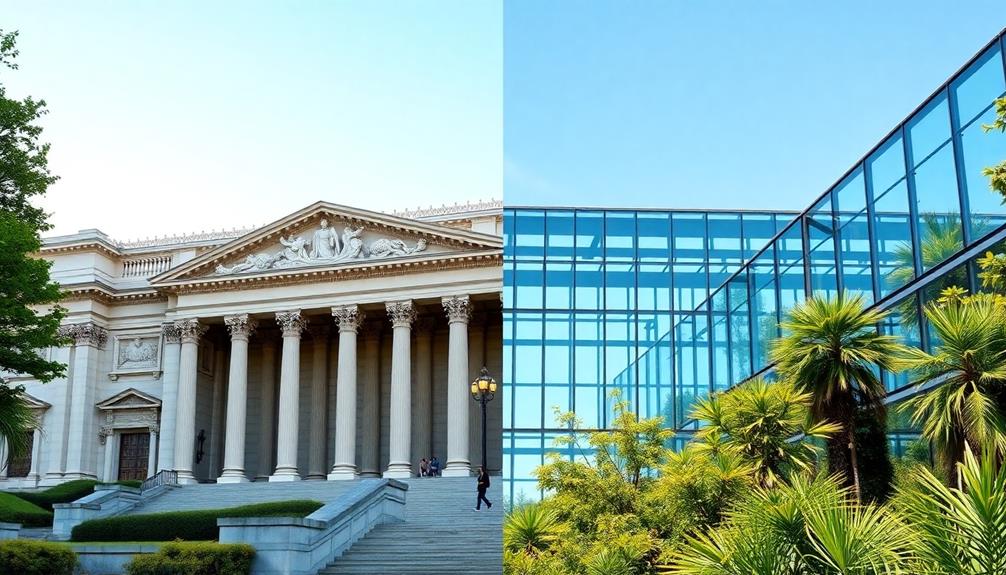
Aesthetic values in architecture reveal a fascinating contrast between classical and modern styles. When you explore these two approaches, you notice distinct characteristics that evoke different feelings:
- Detail vs. Simplicity: Classical architecture dazzles with intricate details, while modern design embraces minimalism.
- Color Palette: Classical works often feature muted, earthy tones; modern designs burst with bold colors and innovative forms.
- Emotional Connection: Classical structures evoke nostalgia and a sense of grandeur, whereas modern spaces inspire innovation and creativity.
- Form and Function: Classical symmetry provides a sense of stability, while modern asymmetry and open layouts promote fluidity and adaptability.
Frequently Asked Questions
How Do Cultural Influences Shape Architectural Styles Over Time?
Cultural influences shape architectural styles by reflecting societal values and technological advancements. You see how preferences for materials, designs, and purposes evolve, creating spaces that resonate with people's experiences, needs, and aspirations throughout history.
What Are Some Famous Examples of Classical and Modern Architecture?
When you explore architecture, you'll find famous classical examples like the Parthenon and the Colosseum. Modern marvels include the Guggenheim Museum and the Sydney Opera House, showcasing the evolution of design and cultural expression.
How Does Climate Affect Architectural Design Choices?
Climate greatly impacts your architectural design choices. You'll consider factors like temperature, rainfall, and sunlight when selecting materials, orientation, and ventilation to enhance energy efficiency, comfort, and sustainability for occupants in various environments.
Are There Any Architectural Movements That Blend Classical and Modern Styles?
You'll discover delightful designs that merge classical and modern styles, like Neoclassicism and New Classical architecture. These movements harmoniously highlight historical elegance while embracing contemporary creativity, creating enchanting spaces that celebrate both eras beautifully.
How Do Architects Balance Aesthetics With Practicality in Their Designs?
You blend aesthetics with practicality by prioritizing functionality while maintaining visual appeal. You consider materials, space utilization, and user experience, ensuring designs are not only beautiful but also serve their intended purpose effectively.
Conclusion
As you stand at the intersection of classical and modern architecture, you can almost hear the whispers of ancient columns clashing with the bold declarations of glass and steel. The grandeur of history and the audacity of innovation dance around you like a vibrant tapestry, each thread bursting with stories. You realize that in this timeless showdown, every structure isn't just a building—it's a powerful symbol of humanity's dreams, aspirations, and relentless pursuit of beauty amidst the chaos of existence.




